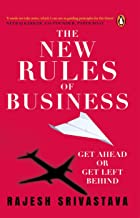The New Rules of Business- Get ahead or get left behind by Rajesh Srivastava (Published by Penguin) ticks all the boxes of a good self-help book. It addresses a pertinent need of today’s times, is direct, simple and to the point. It uses many current and relevant examples to guide modern businesspeople on what has changed in the work landscape. But, for me, what really summarises the essence of this book is an image that one of the chapters left me with- or rather a question…Can you drive ahead by looking at the rearview mirror? If not, this is the book to guide you on the road ahead.
Just like any self-help book aimed at busy people, this one is to the point and packed with helpful content. Each chapter is a ‘rule’ that is articulated in crisp and lucid language. Then there is a section called “Rules in Operation” which talks about how that rule can be applied to modern settings. Here, the author quotes examples of several organisations, most of them the new generation tech firms. The book is applicable to B2B as well as B2C businesses.

Talking Tech
If you take a look around you, you will realize that most of the top companies, new and established have to do with tech. It is either a tech service (Google, Facebook) or it uses technology to fulfil its aim (Uber, Amazon). Hence it is important that these new rules of business consider the tech component. This is what Srivastava emphasizes on. For example, we all know that a pleasant and good customer experience with our product is a must. However, what does customer experience mean in the context of a tech company? Discussion and elaboration of such points have made all the difference. Now taking this a bit further- how would customer experience look like for a B2B business versus a B2C one? Here too, the book has chronicled the differences beautifully.
Another example of what we could learn and apply from new age businesses, comes from another rule where the author describes how customers can be converted into partial or full-time employees. Intriguing right? Consider the example of self-checkin, where the customer does essentially what an attendant would do, and yet saves time! How can one apply this simple principle to modern business?
Consulting….not selling
Another favourite in this book was the difference between consulting and selling. We live in an age where hard selling and pushy salespeople are not welcome. Consumers and customers want experts who will genuinely guide them with correct information about the product or service in question, without any ulterior motive of selling. Sales will follow if the consumer trusts the ‘consultant’.
New-age twist
The USP of this book is the new-age twist. For example, the description of the pay to quit strategy is refreshingly different! I found the chapter on various business models quite informative as well, since most new age companies have adopted a wide range of business models, many of which did not even exist in the past.
Disruptive technology
The world has enough examples of how new enterprises have completely disrupted age old organisations. I think more than the knowledge of the fact that companies must disrupt their own business or someone else will, people now want to understand what exactly constitutes a disruptive mindset. Of course, there are several examples that the author quotes, but the one that really stayed with me the most was that of Netflix. I was not aware that Netflix used to work earlier on a rental model where they had DVDs out for rent! Now, no one really needs any explanation as to how Netflix has reinvented itself and disrupted itself! This thought of disruption for consolidation is what the book rightly concludes with, leaving readers with a lot of food for thought.
“The rules that govern the future need to be entirely different than those that delivered results till recently. To remain relevant, you will have to proactively arm yourselves with the new rules. By embracing the new rules of business, you will take a decisive step towards securing you and your company’s future,” says Srivastava, aptly concluding this helpful book!
Takeaways from The New Rules of Business- Get ahead or get left behind by Rajesh Srivastava
- In every situation do what is good for the customer. Period. Your business will always be in fine fettle.
- Today, customer experience is regarded as the number one source of competitive advantage, ahead of product differentiation and prices.
- Your goal should be to create a situation where the customer acts as a genuine advocate for the brand.
- Don’t train salespeople to be salespeople but train them to become consultants. For this, they need to put the interest of the customer before the interest of the company and give genuine feedback and information to the customer rather than sell the product. This make cause initial loss in sales but ultimately causes a gain in a lifelong relationship with the customer.
- Have a growth mindset versus a fixed mindset. With the former you must always be open to learning and growing. The author recommends setting aside one hour a day, or five hours a week for deliberate learning. This is called the five-hour rule that was also followed by Warren Buffet, Oprah Winfrey and Bill Gates.
- Modern workplaces must be designed to provide bursts of happiness, and encourage creativity and productivity. The principles of Urban Physics can be levered here.
- Today, it is important to embrace omnichannel in whichever field you may be. Online to Offline shopping or O2O is also very common. (Think Zomato, Scootsy), as is the Bricks and Clicks mode or the B&C, that is, a combination of online and physical presence.
- However, some age-old rules still apply. Rule 1 is “better before cheaper” and rule 2 is “revenue before cost”, that is, prioritise increasing revenue before reducing cost.
- The Pivot strategy is also an old one. It is applicable to both tech and non-tech businesses. It is not a bad idea at all. And yes, in this changing world, individuals (and not just companies) can pivot too!
- It is important today to have multiple business models in order to de-risk the business.




